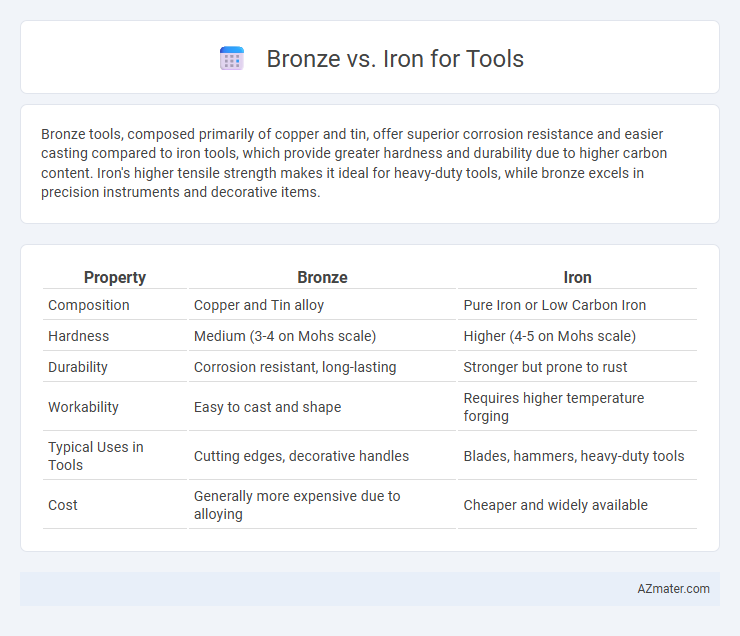Bronze tools, composed primarily of copper and tin, offer superior corrosion resistance and easier casting compared to iron tools, which provide greater hardness and durability due to higher carbon content. Iron's higher tensile strength makes it ideal for heavy-duty tools, while bronze excels in precision instruments and decorative items.
Table of Comparison
| Property | Bronze | Iron |
|---|---|---|
| Composition | Copper and Tin alloy | Pure Iron or Low Carbon Iron |
| Hardness | Medium (3-4 on Mohs scale) | Higher (4-5 on Mohs scale) |
| Durability | Corrosion resistant, long-lasting | Stronger but prone to rust |
| Workability | Easy to cast and shape | Requires higher temperature forging |
| Typical Uses in Tools | Cutting edges, decorative handles | Blades, hammers, heavy-duty tools |
| Cost | Generally more expensive due to alloying | Cheaper and widely available |
Introduction to Bronze and Iron Tools
Bronze tools, made by alloying copper with tin, marked a significant advancement over earlier stone implements due to their improved hardness and durability, enabling more efficient cutting and shaping in ancient societies. Iron tools, introduced later during the Iron Age, offered superior strength, sharper edges, and greater availability of raw materials, revolutionizing agriculture, warfare, and craftsmanship. The transition from bronze to iron tools highlights a critical technological evolution that enhanced productivity and shaped early human civilization.
Historical Development of Bronze and Iron
The historical development of bronze tools marked a significant technological advancement during the Bronze Age, characterized by the alloying of copper with tin to create harder and more durable implements than pure copper. The transition to iron tools in the subsequent Iron Age introduced even stronger and more abundant materials, as iron ore was more widely available and produced tools with superior hardness and edge retention compared to bronze. This shift revolutionized agriculture, warfare, and craftsmanship due to iron's enhanced performance and cost-effectiveness, ultimately leading to the widespread replacement of bronze tools.
Composition and Metallurgy
Bronze is an alloy primarily composed of copper and approximately 12-12.5% tin, with trace amounts of other elements enhancing its strength and corrosion resistance, while iron is a pure metal or alloy mostly consisting of iron with carbon content ranging from 0.02% to 2.1% in steel variations. Metallurgically, bronze's lower melting point (around 950degC) allows for easier casting and intricate tool designs, whereas iron requires higher temperatures (above 1538degC) for smelting, enabling the production of harder and more durable tools. The alloying elements in bronze contribute to its excellent wear resistance and non-sparking properties, while carbon in iron increases hardness and tensile strength, making each metal suitable for different tool applications.
Durability and Strength Comparison
Bronze tools exhibit good durability and resistance to corrosion, making them suitable for a range of applications, but they are generally softer and less strong compared to iron tools. Iron tools, particularly those made from wrought or cast iron, offer superior strength and hardness, which enhances their ability to withstand heavy use and impact without deforming. The higher tensile strength and toughness of iron contribute to its dominance in tool making, especially in scenarios demanding long-lasting, robust performance.
Workability and Ease of Shaping
Bronze offers superior workability compared to iron due to its lower melting point and greater malleability, allowing for easier casting and shaping into complex forms. Iron, while stronger and more durable, requires higher temperatures and more intensive forging processes, making it less practical for detailed or intricate tool designs. The ease of shaping bronze made it the preferred material for early tools and decorative items before advancements in ironworking technology.
Corrosion Resistance and Longevity
Bronze offers superior corrosion resistance compared to iron due to its copper alloy composition, which naturally forms a protective patina, enhancing tool longevity in humid or marine environments. Iron tools, while stronger and harder, are more prone to rust and corrosion unless properly treated or maintained, significantly reducing their lifespan in corrosive conditions. Consequently, bronze remains preferable for tools intended for extended use in environments where corrosion is a concern.
Common Uses in Ancient and Modern Contexts
Bronze tools, valued in ancient civilizations for their durability and corrosion resistance, were commonly used in weaponry, farming implements, and artistic crafts. Iron tools, emerging later, became preferred due to their superior hardness and ability to be sharpened finely, revolutionizing agriculture, construction, and warfare. In modern contexts, bronze remains prominent in specialty applications like bearings and musical instruments, while iron and its alloys dominate industrial manufacturing and infrastructure development.
Economic and Resource Availability
Bronze tools, made from an alloy of copper and tin, were historically more expensive due to the limited availability of tin compared to iron ore, making iron tools more economically viable for large-scale use. Iron ores are abundant and widespread, allowing for more efficient extraction and lower production costs, which accelerated economic growth through affordable tools and weapons. The superior resource availability of iron facilitated its dominance in tool manufacturing, contributing to technological advancement and expanded agricultural productivity.
Technological Advancements Influenced by Each Metal
Bronze tools introduced early technological advancements with increased durability and sharper edges compared to stone, enabling more precise craftsmanship and agricultural productivity. The transition to iron tools marked a significant leap, offering superior strength, availability, and versatility that propelled innovations in construction, warfare, and farming. Iron metallurgy facilitated mass production techniques and the development of complex machinery, driving societal and economic transformations during the Iron Age.
Conclusion: Choosing Between Bronze and Iron for Tools
Choosing between bronze and iron for tools depends on specific usage requirements and resource availability. Bronze offers corrosion resistance and ease of casting, making it ideal for intricate shapes and maritime environments, while iron provides superior hardness and durability, suited for heavy-duty applications. Evaluating factors such as strength, wear resistance, and environmental conditions helps determine the optimal material choice for tool performance.

Infographic: Bronze vs Iron for Tool
 azmater.com
azmater.com